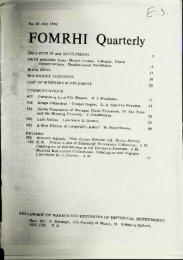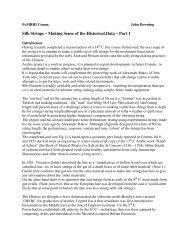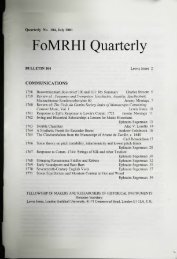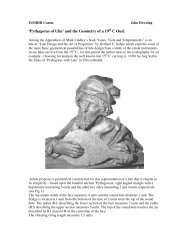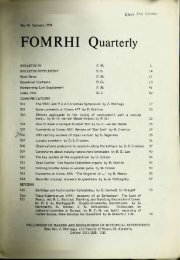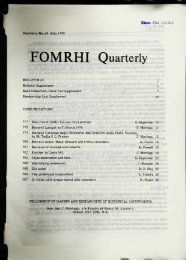• I f - FoMRHI
• I f - FoMRHI
• I f - FoMRHI
You also want an ePaper? Increase the reach of your titles
YUMPU automatically turns print PDFs into web optimized ePapers that Google loves.
38<br />
As regards the second "small" organ it reads in the document: This organ<br />
consists of 7 stops: Principale = Ottava = Quintadecima = Decimanona =<br />
Vigesimaseconda = Voce Umana = e Flauto in Quinta. The keyboard has 45<br />
notes and the short octave in the bass and it has [on the front] 15 tin pipes, the<br />
lowest of which is Elami (E), corresponding to the 13th keyboard note...<br />
From the very detailed report about repairs, materials and costs we know that<br />
there were eight bellows for the great organ and two for the small one. From<br />
the second report, written one year later by Eusanio Gennari 16 , we find out the<br />
name of the builder of the great organ: "Me, organ builder, son of Giovanni<br />
Gennari, constructor of the organ of the Holy Casa del Ponte ..."<br />
We know that 15 of the 2266 pipes were made of wood. After moving to the<br />
Abruzzi, Giovanni Gennari did important work in other towns apart from<br />
Lanciano (for example, in 1809 he built the organ of the cathedral of Citta San<br />
Angelo 17 ), even if it is certain that he and his family were requested to work in<br />
the Frentana region. In fact, almost all of the members of Gennari's family<br />
remained engaged in their father's activity: Eusanio and Quirico, Giovanni's<br />
sons, were organ builders; Gaetano and Lelio, Quirico's sons, also worked as<br />
renowned organ builders. Another constructor of musical instruments,<br />
Quirino, was the son of one of Giovanni's daughters, Cecilia, who was married<br />
to Nicola Vincenzo Cipollone. Luigi Di Diego, together with his brother,<br />
followed Quirino Cipollone in the activity of pianoforte maker and tuner 18 .<br />
About all these persons we have information. As early as 1853 Eusanio restored<br />
"a regola d'arte" (according to the rules) the great organ 19 and in 1865 he was in<br />
charge of its maintenance, after the "maestro di cappella" Francesco<br />
Masciangelo 20 had suggested him to become responsible for its care. In a letter<br />
of 2 June 1865, Eusanio recalls that he was "the brother of the renowned organ<br />
builder Mr Quirico, who cooperated with many others in the restoration of the<br />
big organ of the church of S. Francesco di Paola in Naples" 21 . In 1853, the<br />
period of Eusanio and Quirico German's activity, the above-mentioned Quirino<br />
Cipollone also worked in Lanciano. He was responsible for the care of the<br />
organ of the cathedral, as appears from his letter of 24 June 1864 in which he<br />
demands "the 12 ducats" for the care of the Santa Casa organ 22 . Of the same<br />
Cipollone we have an interesting clue: he built the pianoforte which was<br />
subsequently in possession of the composer Francesco Masciangelo. The<br />
instrument, numbered 56, is preserved by the heirs in Lanciano. When in 1855<br />
Quirino Cipollone was registered as "organista" in the register of Lanciano 23 he<br />
must have been 47 years of age, as he was born on 11th January 1810 (he died<br />
on 24 July 1864 24 ). Formerly he was called "maestro di musica" (composer and<br />
director). Quirino Cipollone lived in the Civitanova quarter; he was twice<br />
married and had six children: Mattia, Vincenzo, Teresa, Lucia, Maria Concetta<br />
and Maria Bambina. Mattia Cipollone, still a renowned composer of Lanciano,<br />
studied in the San Pietro a Maiella Conservatory in Naples and made a brilliant<br />
career; he was called "musico" at the age of 21 in 1858. In fact he was accepted





